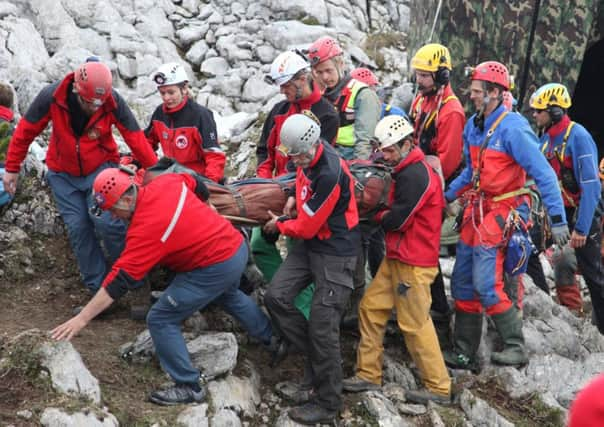Hurt man saved from Germany’s deepest cave


It took more than 700 people from five countries to retrieve Johann Westhauser, an experienced caver, who had gone into the Riesending cave system in the Alps, near the Austrian border, with two companions.
He suffered severe injuries to the head and chest after he was caught in a rockfall on 8 June while nearly 1,000 metres (3,300ft) underground.
Advertisement
Hide AdAdvertisement
Hide AdThe German explorer had been trapped in the cave’s depths for 12 days before finally being brought to the surface yesterday after a painstaking rescue operation.
Two doctors accompanied him to the surface and, after initial checks, he was airlifted to hospital.
The rescue effort required lengthy preparations before teams began the arduous task of hauling him up through a labyrinth of narrow passages and precipitous vertical shafts five days later.
The sheer intricacy of the cave’s interior meant that the precarious rescue was beset with difficulties, and the laborious task involved rest periods in five bivouac stops.
The operation was not helped by the fact that they could not use a motorised winch because of the potential risks to Mr Westhauser, forcing them instead to haul him up manually on a fibreglass stretcher.
Rescuers brought the 52-year-old the final 590ft to the surface yesterday. The extent of his injuries are yet to be confirmed.
Mountain rescue service chief Klemens Reindl, who supervised the operation, said: “It was one of the most difficult rescue operations in the history of the mountain rescue service.
“The international character of the mission was remarkable.”
Advertisement
Hide AdAdvertisement
Hide AdBavarian mountain rescue chief Norbert Heiland added: “A chapter of Alpine rescue history has been written here over the last 12 days.”
He said officials initially doubted whether a rescue was possible.
It had become a huge media event with multi-page spreads on the caver’s incredible adventure in German newspapers. In all, 728 people from Germany, Austria, Switzerland, Italy and Croatia participated in the rescue operation.
“Since the birth of caving, there have been only two incidents of this depth, complexity and difficulty,” Italian rescuer Roberto Conti said.
A fit expert could climb from the accident site to the entrance in about 12 hours, but rescuers had to haul Mr Westhauser on a stretcher. The cave entrance is on a mountainside, 5,900ft above sea level.
Mr Westhauser’s condition has been described throughout as stable and Mr Reindl said he “came through the rescue operation well”.
The injured man was one of the explorers who in 1995 originally discovered the cave, which they named Riesending, which translated means giant thing, because of its depth and extent.
Mr Westhauser works at the Institute for Applied Physics at the Karlsruhe Institute of Technology, but it is not known if he went into the cave complex – as he had done many times before – as part of his research or in pursuit of his hobby.
Advertisement
Hide AdAdvertisement
Hide AdThere are sound scientific reasons to explore caves, but there are some cavers who do it for the thrill of going where no human may have trod before.
Bavaria’s top security official said he wants to make sure the highly publicised rescue does not attract “risk tourism”.
Interior minister Joachim Herrmann advocated shutting the cave entrance to ensure it was accessed only by experts.